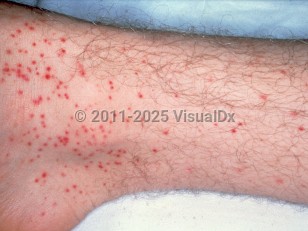Atypical measles syndrome
Synopsis

Patients with atypical measles syndrome typically develop a prodrome characterized by high spiking fever (up to 40°C [104°F]). This is accompanied by myalgia, cough, and headache. The polymorphous rash that develops is erythematous, macular or papular, and begins on the extremities and spreads to involve the trunk. The lesions then become vesicular, petechial, or purpuric. The exanthema generally occurs on the third to fourth day of the illness. Prostration, headache (which may be occipital), nausea, and vomiting may be followed by a sore throat, conjunctivitis, and photophobia. Cough, occasionally with pleuritic pain, is almost universal. A severe pneumonitis occurs in most patients and may be life-threatening. The illness appears to be self-limiting, lasting from 3 to 10 days. Additional clinical features may include abdominal pain and hepatic dysfunction.
Hospitalization should be considered. Other complicating features of the disease can range from mild to severe and include otitis media, pneumonia, acute thrombocytopenic purpura, and encephalitis (2-7 days after the start of the rash). A late and rare complication is subacute sclerosing panencephalitis, which presents with mental deterioration, behavioral changes, and myoclonic jerks.
Related topic: measles
Codes
B05.89 – Other measles complications
SNOMEDCT:
240483006 – Atypical measles
Look For
Subscription Required
Diagnostic Pearls
Subscription Required
Differential Diagnosis & Pitfalls

Subscription Required
Best Tests
Subscription Required
Management Pearls
Subscription Required
Therapy
Subscription Required
References
Subscription Required
Last Updated:03/27/2025

